Weeping Pussy Willow: Salix Caprea Pendula Care
A Weeping Pussy Willow is a beautiful addition to a garden. Here are care tips to keep this small, attractive tree healthy and looking its best.
My San Francisco Bay Area client ordered the one from Wayside Gardens as a new plant around 2001, which I planted and then maintained. It’s not a plant commonly sold in those parts, so I was very curious to see how it would do.
Although there were quite a few Pussy Willows growing around the pond on my childhood farm in New England, I didn’t even know there was a weeping variety. Gardening is often experimentation, and I love weeping plants, so I said, “Why not give it a go?” Besides, it had already arrived on the doorstep.
I no longer live in San Francisco, and the owner recently sold the house. I maintained this plant for over fifteen years, and although I no longer am a professional gardener, this post badly needed an update!
Note: This post was published on 1/20/2016. It was updated on 2/26/2024.
Weeping Pussy Willow Plant Traits
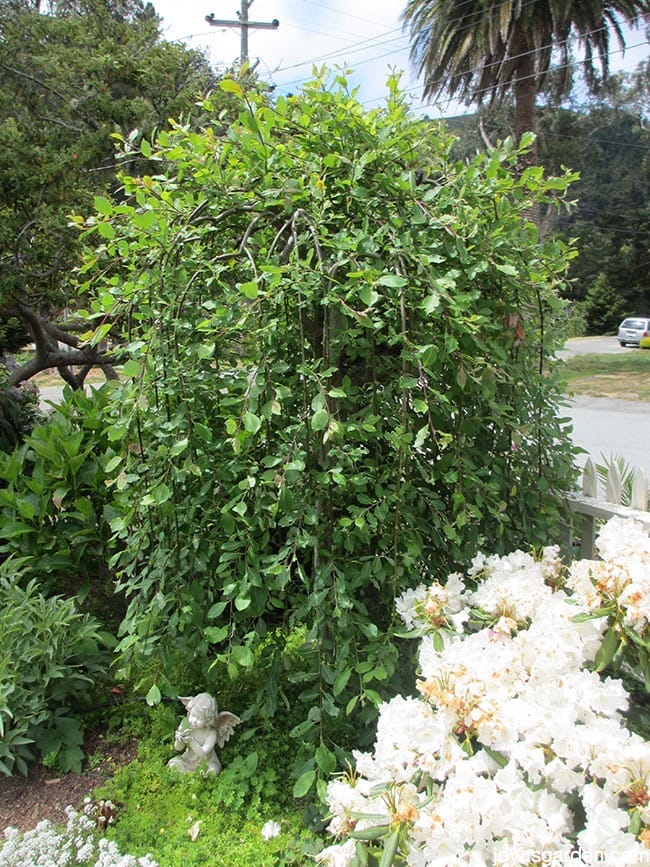
Botanic Name: Salix caprea Pendula Common Name: Weeping Pussy Willow
Growing Zone
By the USDA Plant Hardiness Map, the Weeping Pussy Willow is recommended to be grown in zones 4-8. Zone 4 reaches -24 degrees F, so this plant can handle cold winters.
By the way, the one you see here grows in zone 9b – 10a. This is out of the recommended zone, but it’s doing good. I’ve seen a couple growing pondside in England; they were gorgeous!
I planted this one in the spring, but fall is fine, too, as long as it has time to settle in before a frost.
Size
This unique weeping garden accent shrub is already over 7′ tall. The width is about the same. I believe they max out at 8-10′.
It has a low canopy, not suitable for adults to sit or stand under. Her young nieces liked to sit under it and have private “fairy tea parties.”
Growth Rate
Pussy Willows grow at a fast rate. It has grown in width more than in height and turns into a massively foliated blob if not pruned two or three times a year in the temperate coastal California climate.
Big Draw
The rounded, interesting form and the fact that it stays small make it appealing. They’re the harbingers of spring, as their fuzzy catkins are some of the first to appear, even before the foliage.
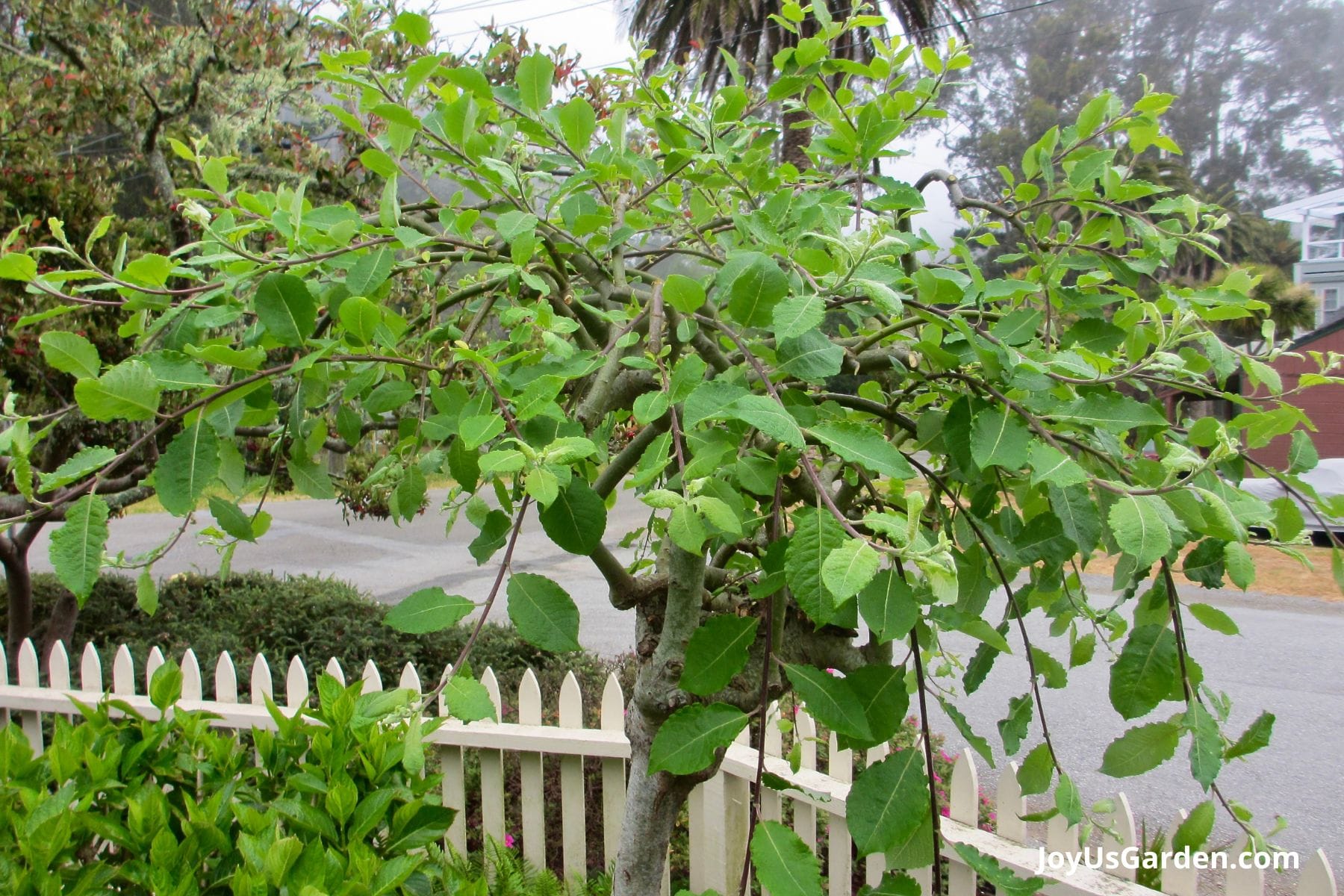
Weeping Pussy Willow Care
These plants are tough and are pretty easy to maintain. We lovingly nicknamed the plant pictured here “Cousin Itt” & later shortened that to just “Itt.” And yes, when left unpruned, they turn into the leafy versions of the amusing character from the Addams Family.
Exposure
The Weeping Pussy Willow prefers full sun but will do fine in part sun as long as it’s afternoon sun. The one you see here is planted in a very sunny spot, but it’s on the California coast, so mornings and late afternoons are usually foggy.
Not enough sun equals poor flowering and a reduced growth rate.
Water Requirements
These plants like regular watering and look much better with it. This one is on drip irrigation and is located in a part of the garden where the water flows down a hill and collects in this spot.
Pussy Willows grow just fine alongside ponds and don’t mind having their feet moist in soggy soils. They can even tolerate standing water. If yours has dried out, be sure to give it a long drink of water.
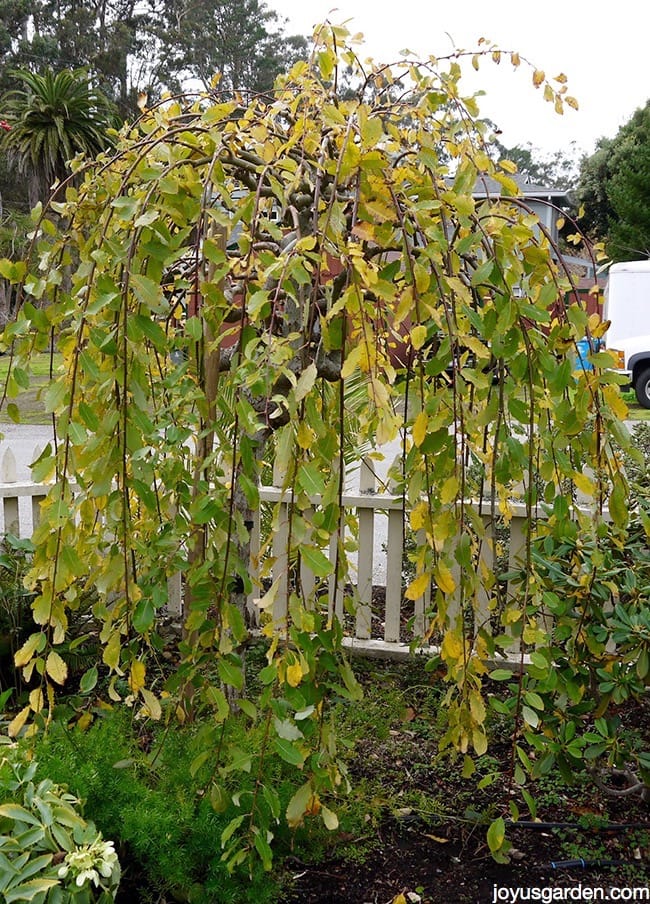
Soil
Simply put, the WPW isn’t fussy about soil but prefers it slightly on the acidic side. If you think yours needs a bump up on the nourishment factor, you can amend the soil with leaf mold or a good local compost – the plant will love you.
I planted this one in the spring, but fall is fine, too, as long as it has time to settle in before a frost.
Feeding
I’ve never fertilized this one, but threw lots of leaf mold, compost, and coco coir into the hole upon planting. This garden gets a 2-3″ top dressing of a local, organic compost (over ten cubic yards of it!) every two years, which the Weeping Pussy Willow thoroughly enjoys.
I don’t think yours will need it, but a balanced all-purpose fertilizer (10-10-10 or 15-15-15) applied once during the growing season will help out if you feel it’s nutrient-deprived.
Pruning
This one has grown in width more than in height and turns into a massively foliated blob if not pruned two or three times a year in the temperate coastal California climate.
Some people just let theirs go in terms of pruning. These look great in more of a natural setting. The garden this WPW grows in is a cultivated, semi-formal style, so the plant looks better thinned out and opened up a bit.
I love to prune, and giving Cousin Itt a haircut was a creative challenge I actually enjoyed. The best time to prune this plant is in the early spring after it flowers.
Because the one you see here grows in a temperate climate, I pruned it three times a year to keep it in a more refined form. Once in early spring, once in midsummer, and once in early fall.
In 2011, I had to rehab it from a terrible pruning job, a severe hack, I tell you! Because these weepers grow vigorously and are so tough, this one returned to its former self within a year or so.
I gave this Weeping Pussy Willow a year or two to get going before I pruned it. Here’s how I pruned this plant when it got older and more established. Make sure your pruning tools are clean and sharp.
1) Remove all the sprouts coming off the trunk.
2) Remove the branches that cross over other branches.
3) Thin out the main branches to open the plant up.
4) Remove some of the smaller branches on the top that are growing upwards. Remove all branches growing up if you don’t want your plant to grow any taller. This plant is slowly getting taller because I leave about half of them.
5) Remove some branches that grow laterally off the main branches. This branching tends to occur on the bottom half of the branches.
6) In all of the previous steps, be sure to take the branches you’re pruning off all the way back to a main branch. Otherwise, you’ll get more lateral growth than you want.
7) I prune the remaining branches up a few inches off the ground. Even though this causes lateral branching, I don’t want it smothering all the poor unsuspecting plants below.
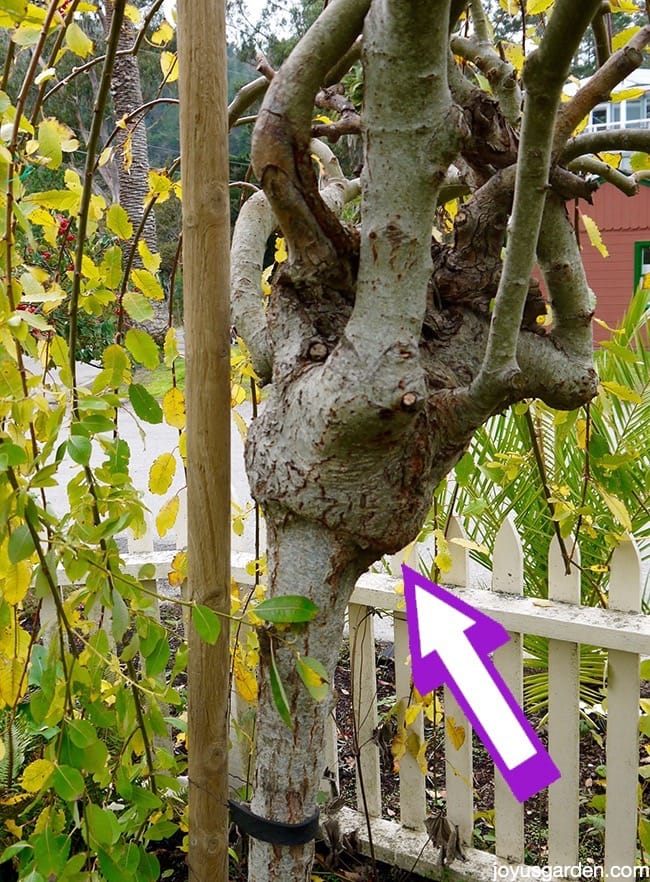
Staking
As the image above shows, this small tree needed to be staked. This unusual tree grows in a windy valley just seven blocks from the Pacific Ocean and blew over in one of the winter storms when it was about eight years old. A few days later, it was uprighted, and a large lodge pole stake was added.
It has a bit of a lean, but it’s so full it’s hard to notice. This plant is very resilient, I tell you!
Flowering
This is one of the Pussy Willow features that people love! These harbingers of spring have large fuzzy catkins, which are inflorescences of many tiny flowers.
The grey furry “pussies” (no dirty minds here, please!) are what we love to cut on long branches and put in a vase in spring. The masses of tiny yellow flowers will later emerge from those furry nodes.
Here are two reasons that your Weeping Pussy Willow may not be flowering:
1) Not enough sun OR
2) A late frost strikes after the catkins have started to appear and wipes out the flowering.
Pests
One year, this plant had a mild infestation of scale insects. We used neem oil to control it. They’re also susceptible to aphids and caterpillars.
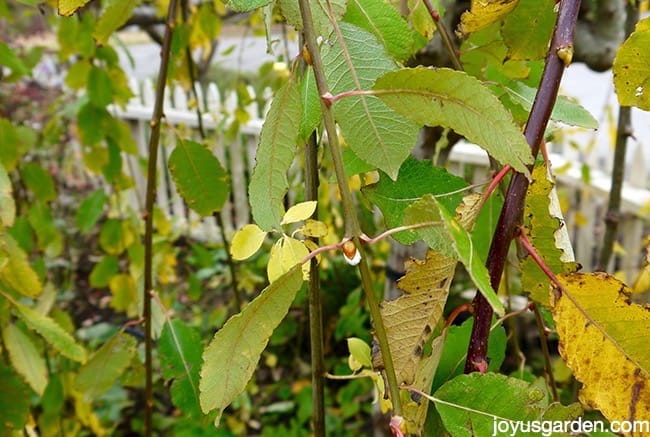
Important Things To Know
1) This plant is grafted. I show the graft in the video below and the photo with the arrow.
A Weeping Pussy Willow is grafted on top of a regular Pussy Willow trunk to get the tree form. So, never cut off below the graft because the plant will revert to the bush form.
2) The Weeping Pussy Willow is a deciduous tree, so don’t worry when it starts to lose its pointy leaves.
3) If you want your PW to grow taller, leave some of the new shoots emerging at the top.
Pussy Willow Care FAQS
Yes, you can. As the plant ages, it’ll need a large container (with drainage holes) to accommodate the root ball size. Pussy Willows like rich soil, so be sure to amend with compost. They need a sunny location and naturally grow in wet areas, so don’t let yours completely dry out.
I honestly don’t know how long they ultimately live. This one was planted in 2001; I last saw it in 2019, and it looked good. You want to make sure it’s getting the light and water it needs. Most need staking, especially when establishing. Depending on the look you’re going for, you can let it become a full blob; you’ll need to do some pruning.
I’d avoid it. This ornamental tree grows densely, and the roots can be invasive. Besides, the plants underneath would be shaded out. I planted a Sprengeri Fern (another toughie) about 3′ from the trunk of this plant, and it scampered all around it.
It would certainly appreciate that. We applied a 3″ layer of mulch (locally produced) in late winter/early spring every other year. This one was growing in a climate with dry summers, so the mulch helped hold the soil moisture in.
Weeping Pussy Willow Video Guide:
Conclusion: Weeping Pussy Willow trees are easy as pie if you don’t mind doing some pruning every now and then. They need a good amount of sun, regular watering, and to be staked when young. Warning: this small ornamental tree may steal the show in your garden!
Happy Gardening,

This post may contain affiliate links, you can read our policies here.
- About the Author
- Latest Posts
Nell, the founder of Joy Us garden, was born into a gardening family and grew up in Connecticut’s countryside. After living in Boston, New York, San Francisco, & Santa Barbara, she now calls the Arizona desert home. She studied horticulture & garden design, working in the field all her life. Nell is a gardener, designer, blogger, Youtube creator, & author. She’s been gardening for a very long time & wants to share what she’s learned with you.










Hi Diana – A WPW is a grafted plant. The only way your WPW will revert to bush form is if you prune off the part below the graft. The stem gets occasional shoots but most of the growth should be above the graft. Nell
I planted this willow last spring and it seemed like this spring everything started out alright but now it has no leaves and the bids didn’t open up. Real talk, is there any salvaging this poor tree?
Bevlyn – Pussy Willows need plenty of water to survive. Scratch a bit of the bark off & see if the tree is still alive. Nell
Can a Weeping Pussy Willow Tree that has been grafted be kept in a planter
Yes. Unless it’s a dwarf, you’ll need to increase the pot size as the plant grows to accommodate the root ball. Nell
I have purchased two starter weeping pussy willow trees. They are now in a pot. Since it’s now summer, can I take them outside or just keep them indoors.
Hi Dale – I’ve never grown 1 outdoors. I don’t think it would do well for the long haul. Nell